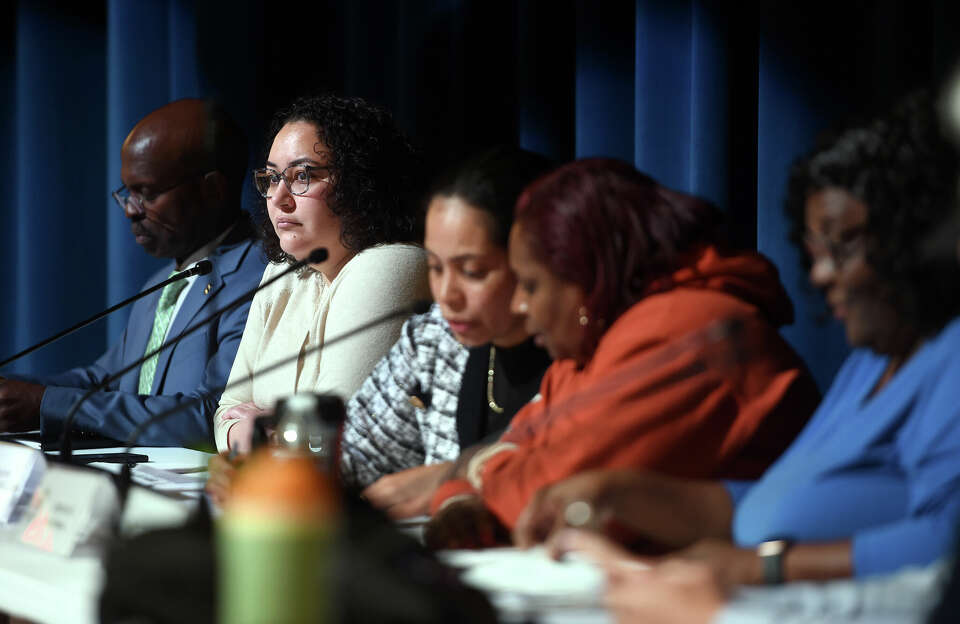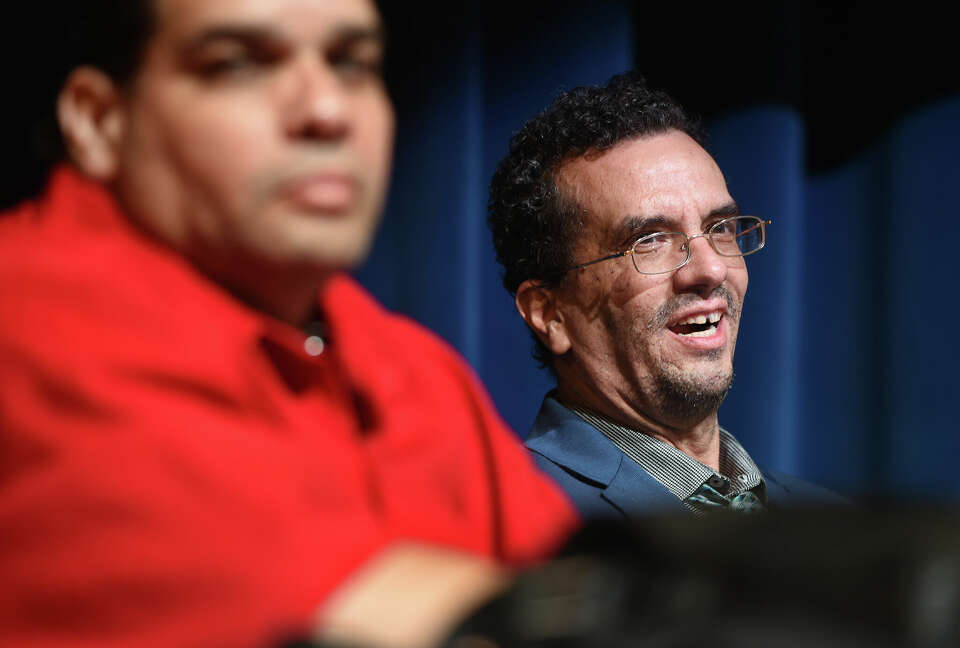
File photo from the Annual Organizational Meeting of the Board of Education in Bridgeport in December 2024. The Bridgeport school board is considering drastic cuts to balance the fiscal 2025-26 budget.
Arnold Gold/Hearst Connecticut Media

Joseph Sokolovic, right, in a file photo after being elected vice chair of the Bridgeport Board of Education at the Organizational Meeting of the Board of Education in December 2024. The Bridgeport school board is considering drastic cuts to balance the fiscal 2025-26 budget.
Arnold Gold/Hearst Connecticut Media
BRIDGEPORT — The city school board is considering cutting more than three dozen teacher positions and furloughing all district employees for a week to help close a $28 million budget shortfall.
The aggressive belt-tightening plan, which has not yet been approved, also calls for the elimination of all school librarians, a popular after-school performing arts program and bus transportation for about 2,500 students.
The proposal was presented to the board’s finance committee Thursday. The full panel is expected to spend the coming weeks evaluating the various cost-saving measures before adopting a spending plan.
“State law makes us balance the budget,” Vice Chairperson Joseph Sokolovic said. “Nobody on the board wants to get rid of teachers or make any of these cuts. It's the state of Connecticut that’s put us in this position.”
Chief Financial Officer Nestor Nkwo said the district’s projected deficit now stands at $28.1 million, despite Mayor Joe Ganim’s recently unveiled proposal to increase city funding for the cash-strapped school system by $3 million.
The board voted last month to request an additional $25 million from the city to avoid the cuts and to help cover the costs for a proposed $348 million budget for the upcoming 2025-26 fiscal year.
District officials have attributed the shortfall to the expiration of millions of dollars in federal aid provided in the wake of the coronavirus pandemic, the hiring of new administrators and a lack of funding from the state.
Interim Superintendent Royce Avery and other locals have urged state lawmakers to provide $57 million in additional funding by adjusting the formula that determines the annual state funding allocation, but it is unclear if the money will materialize.
Jeff Morrissey, the president of the Bridgeport Education Association, the union that represents the district’s about 1,400 full-time teachers, said he hopes the district can secure additional money to avoid the potential cuts.
“The proposals offered to balance the district’s budget are certainly alarming and will have a detrimental impact on everyone involved,” Morrissey, a longtime teacher, said in a statement.
The proposed cuts include eliminating 40 teacher positions, a move that would save $3.4 million if approved. Officials said the district would attempt to eliminate the jobs through attrition, though they did not rule out the possibility of layoffs.
The largest savings would come through furloughing all district employees for a total of five days over the course of the school year. The step would allow the district to conserve about $4.6 million by not paying wages for the furlough days.
According to budget documents presented to the school board, the district could save another $4.6 million by increasing the distance some students must walk to school by at least half a mile.
The district currently only provides transportation for elementary and charter school students who live further than a mile from school and for traditional high school students who live more than 2 miles away.
The recommended change, which echoes a controversial plan from 2019 that was later dropped, would mean that more than 1,700 elementary students and 600 high schoolers would no longer be eligible for free daily busing.
District officials said an additional $2.5 million could be saved by reviewing special education programs and providing in-house education for some students who the district currently pays to be educated in private facilities outside the city.
The proposal suggests the school system could save $1.7 million by eliminating all of the district’s 15 librarians, about $1.4 million by maxing out class sizes and cutting long-term substitutes, and $1.3 million by getting rid of kindergarten paraprofessionals.
The district’s performing and visual arts program, including the FAME Afterschool Arts Academy, is also on the chopping block. Officials project cutting the popular program and associated staff would save more than $400,000.
Nkwo said the recommended cuts include eliminating four social workers, four counselors, five assistant principals, three climate specialists and five central office staffers. He is also proposing to cut $900,000 in curriculum costs and $300,000 in legal expenses.
The proposed cuts would be on top of the millions of dollars in cost-saving measures the school system has already implemented to help fill the massive budget gap, including the moves in recent months to eliminate about 80 positions and various programs.
The deficit was among the reasons the State Board of Education voted earlier this year to give Commissioner of Education Charlene Russell-Tucker the authority to intervene in the struggling district, including the power to approve the appointment of the next superintendent.
Steven Douglas, the president of the Bridgeport Council of Administrators and Supervisors, the union that represents school administrators, said in a statement that Bridgeport families deserve schools that are fully staffed.
“The Bridgeport Board of Education, the city of Bridgeport and the state must work together to fully fund our schools to meet the varied needs of every Bridgeport student,” Douglas, the principal of Geraldine Claytor Magnet Academy, said.
During the committee meeting, board members largely expressed concern about the scope of the cuts and the impact they will have on the classroom, but did not explicitly reject any of the cost-saving measures.
Board member Maritza Estremera-Jimenez, who was appointed to the panel in February to fill a vacant seat, said she is worried that without a dramatic infusion of outside funding, the school system will struggle to provide a quality education.
“We have a fiscal responsibility to balance the budget,” Estremera-Jimenez said. “But the options that we have to take and the decisions that we have to take today are atrocious, and they’re horrible for our children.”
